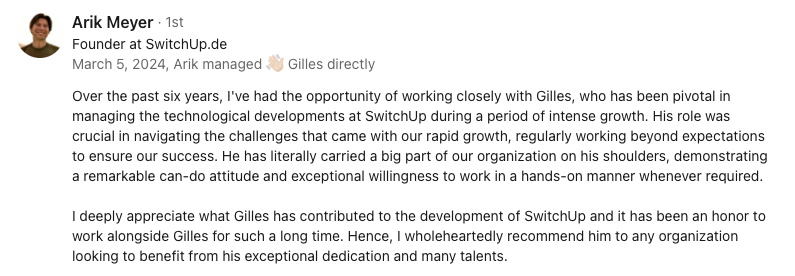Abstract:
The landscape of work is undergoing a profound transformation, fueled by the rise of co-working spaces and digital nomadism. This trend is reshaping how professionals engage with their work environments, offering unprecedented flexibility and fostering a new culture of collaboration. Co-working spaces are not just physical locales but vibrant communities that provide a platform for networking, innovation, and productivity outside the traditional office setting. Simultaneously, digital nomadism embraces the possibility of working from anywhere in the world, powered by technology. This movement is gaining momentum, driven by the desire for a better work-life balance and the technological advancements that make remote work more feasible and effective. These developments signal a shift towards more dynamic and adaptable work models, challenging organizations to rethink their approaches to workspace design, team collaboration, and employee engagement.
transformation in work landscapes
Picture this: a laptop-toting professional, sitting in a beachside café in Bali, sipping on a coconut while effortlessly juggling tasks for clients spread across three continents. Or, consider a bustling downtown co-working space where freelancers, startups, and remote employees from various companies exchange ideas over a cup of artisanal coffee. These picturesque scenarios are becoming quite common as the work landscape undergoes profound changes.
Co-working spaces and digital nomadism are the two significant trends reshaping how and where we work. Gone are the days when a traditional office with cubicles was the default. Instead, what we see today is a dynamic shift towards more flexible, collaborative, and location-independent work styles. This transformation is not just a passing fad; it’s a fundamental alteration in our approach to work.
Take WeWork, for instance—a name synonymous with the co-working revolution. Starting with a single location in 2010, WeWork has mushroomed into one of the most recognizable brands in the shared office space industry. Their appeal lies not just in providing a desk and Wi-Fi, but in creating an energetic community where like-minded professionals can connect, collaborate, and grow.
On the flip side, digital nomadism has taken the work-from-anywhere concept to a whole new level. Thanks to advancements in technology and connectivity, professionals can now work from virtually any corner of the globe. This movement isn’t limited to freelancers or entrepreneurs; even permanent employees are negotiating remote work arrangements, enabling them to live a life of exploration and flexibility. Imagine wrapping up a meeting via Zoom from a quaint café in Paris, or finishing a project while basking in the serenity of a Japanese garden—tempting, isn’t it?
These trends are not just about new places to work but about creating new ways to work. They cater to a growing workforce seeking purpose, flexibility, and community. As we dive deeper into this article, we will explore how co-working spaces and digital nomadism are transforming the professional world, the challenges and opportunities they present, and what the future holds for organizations that wish to thrive in this new age of work.
co-working spaces: beyond physical locales to vibrant communities
Let’s face it: co-working spaces are not just about finding a desk anymore. They've evolved into vibrant hubs teeming with innovation, creativity, and a sense of community that can turn any workday into a rewarding experience. Sure, you can get Wi-Fi and a comfortable chair, but the real value lies in the dynamic ecosystem that fosters networking, collaboration, and even a bit of fun.
a melting pot of creativity and collaboration
Think of these spaces as the modern-day equivalent of a marketplace. Instead of trading spices, professionals exchange ideas, knowledge, and skills. You might find a startup founder brainstorming with a freelance designer or a remote software developer discussing the latest technologies with a marketing consultant. The magic happens in these spontaneous interactions, sparking innovation and driving business growth. It’s like having a serendipity engine right where you work.
more than just amenities
Co-working spaces are designed to cater to the needs of various professionals. From state-of-the-art meeting rooms to fully stocked kitchens and relaxation zones, the amenities are top-notch. But it’s the additional services and events that make these spaces truly special. Many co-working spaces offer:
- Workshops and Training Sessions: Whether you want to brush up on your coding skills or learn about the latest marketing trends, there's likely a session for that.
- Networking Events: These are gold mines for anyone looking to expand their professional circle. From happy hours to industry-specific meetups, the opportunities are endless.
- Mentorship Programs: Many spaces connect members with seasoned professionals who can offer guidance and insights, proving invaluable for newbies and veterans alike.
Take Impact Hub, for example. It’s not just a place to sit and type—it’s a launchpad for social entrepreneurs. With a global network, Impact Hub provides various programs and events that inspire and connect members, fostering a community that’s as supportive as it is innovative.
boosting productivity and morale
Working from home in your pajamas might sound appealing, but let’s admit it: the isolation can get to you. In contrast, the social aspect of co-working spaces often leads to higher productivity and morale. The ambient noise, the buzz of activity, and the availability of support services can turn even the most mundane task into an enjoyable activity.
Speaking of productivity, a survey by GCUC (Global Coworking Unconference Conference) reported that 84% of participants found they were more engaged and motivated in a co-working space. That’s no small feat. It’s this sense of belonging and mutual support that makes all the difference. As Jane, a freelance copywriter, puts it, “I come for the Wi-Fi, but I stay for the community. It’s like having an office family without the office politics.”
the future is community-centric
As more professionals seek flexibility and community, co-working spaces are likely to become even more integral to our work lives. They’re not just about redefining where we work but how we work, fostering environments where people feel empowered to innovate, collaborate, and succeed.
So, next time you find yourself longing for a change of scenery or some professional camaraderie, consider giving a co-working space a shot. Who knows? You might just find your next big idea—or at least a fantastic new coffee spot.
the rise and impact of digital nomadism
Ever dreamt of sending emails from a beachside cabana or attending virtual meetings from a mountaintop chalet? Welcome to the world of digital nomadism. This lifestyle, popular among modern professionals, is like a breath of fresh air—literally! Thanks to rapid advancements in technology, more and more people can now work from practically any corner of the globe, combining work and wanderlust seamlessly.
technology as the enabler
Let’s face it—without reliable high-speed internet, cloud computing, and a suite of collaborative tools, the digital nomad lifestyle would merely be a pipe dream. Applications like Slack, Zoom, and Google Workspace have become the linchpins that allow professionals to communicate and collaborate effectively, no matter where they are. These technological marvels make it possible to stay productive while hopping from one exotic locale to another. Who wouldn’t want to draft reports from a beachfront villa in Bali or close deals from a Parisian café?
why digital nomadism appeals
It's not just about the picturesque settings; the rise of digital nomadism also speaks to a broader quest for balance and flexibility in life. For many, the shift from a 9-to-5 grind to remote work offers the opportunity to blend their professional and personal lives more harmoniously. A 2020 study by MBO Partners revealed that 10.9 million American workers described themselves as digital nomads. That’s a significant surge, up 49% from the previous year. Clearly, this movement is not just a phase but a growing preference.
stories from the road
Personal accounts add a touch of color to these statistics. Take Robert, a software developer who traded his cubicle for a camper van outfitted with solar panels and a 4G router. “I’ve coded from sandy deserts and snowy peaks,” he recounts. “The freedom to explore while staying productive is unbeatable.” Or consider Maria, a marketing consultant who now designs campaigns while sipping coconut water in Thailand. “The work is the same,” she says, “but my office view is breathtaking—and the fresh air really boosts creativity!” These stories underline how location independence can foster a uniquely fulfilling work-life balance.
impact on the traditional workplace
Organizations are taking note. With the increasing demand for remote work arrangements, companies are rethinking traditional office setups. According to a Gartner survey, 82% of company leaders plan to allow employees to work remotely at least some of the time, even post-pandemic. This shift is more than just a reaction to current events; it’s an adaptation to changing employee expectations and technological possibilities.
Remote work doesn’t just benefit employees; employers gain too. Lower overhead costs, access to a global talent pool, and happier, more productive employees are all part of the package. However, it’s not without its challenges. Coordination across time zones, maintaining company culture, and ensuring secure communications are all hurdles that need overcoming. But hey, if our ancestors could brave the seven seas, surely we can manage a few Zoom calls across time zones, right?
looking ahead
The trend towards digital nomadism shows no signs of slowing. Whether it's the lure of adventure or the quest for a balanced lifestyle, more professionals are opting to pack their laptops along with their suitcases. For companies, this means embracing a mindset that values flexibility and innovation. The future of work is here, and it might just be clicking “send” on that deadline while lounging in a hammock.
So, next time you see a picture of someone tapping away on a laptop with a scenic backdrop, remember—they might just be closing a big deal or crafting a groundbreaking project while living their dream of exploration and flexibility. Sounds tempting, doesn’t it?
challenges and opportunities for organizations
Switching gears from the individual benefits to the organizational impact, it’s clear that the rise of co-working spaces and digital nomadism is forcing companies to rethink a lot of things, from how they design workspaces to how they manage teams. If you thought managing your fantasy football league was challenging, try juggling a workforce spread across multiple time zones and continents!
rethinking workspace design
Gone are the days of one-size-fits-all office layouts. Companies need to create flexible workspaces that can adapt to various needs. Think modular furniture, open-plan designs that easily convert into private spaces, and tech setups that facilitate seamless remote communication. The good news? This flexibility can actually foster creativity and innovation. However, let’s not forget that the initial investment in redesigning these spaces might have your CFO reaching for the antacids.
team collaboration challenges
With employees no longer sharing the same physical space, collaboration and communication can take a hit. Water cooler conversations? A thing of the past. Companies need to invest in robust communication tools—think Slack channels, Zoom meetings, and project management software like Asana or Trello. But it’s not just about tools; fostering a culture of collaboration is key. Regular virtual team-building activities may sound cheesy, but they can make all the difference in keeping the team spirit alive.
employee engagement
Keeping remote employees engaged is like trying to keep a cat interested in a single toy—it’s tricky! Remote work can lead to feelings of isolation, so companies need to get creative. Regular check-ins, virtual coffee breaks, and perhaps even an occasional meme-sharing contest could help. Additionally, recognizing achievements and providing avenues for professional growth can keep employees motivated. After all, everyone loves a little pat on the back—or a virtual high-five!
opportunities for innovation
Here’s the silver lining: embracing these trends can significantly enhance an organization's agility and innovation. Remote work allows access to a global talent pool, enabling companies to hire the best person for the job, regardless of geography. It also encourages a culture of innovation, as diverse teams bring varied perspectives to the table.
recommendations for thriving
So how can organizations make the most of these trends? Here are some strategies:
- Flexibility is Key: Offer flexible work arrangements to attract and retain top talent. Whether it’s flexible hours or remote options, giving employees control over their work environment can lead to higher job satisfaction.
- Investment in Technology: Equip your teams with the tools they need to collaborate effectively. This includes not just software but also training on how to use these tools efficiently.
- Foster a Community: Create a strong corporate culture that transcends physical locations. Regular virtual team-building activities, recognition programs, and open communication channels can help.
- Health and Well-being Programs: Support your employees' mental and physical health with wellness programs, mental health days, and perhaps even subscriptions to meditation apps.
As organizations navigate this new work environment, those who embrace flexibility, innovation, and employee well-being will likely find themselves thriving. And who knows—maybe the next big idea will come from a brainstorming session held on a beach in Bali. Cheers to that!
You might be interested by these articles:
- Work Anywhere, Together
- Co-working Spaces: A Startup's Secret to Compliance and Growth
- Embracing Flexibility: The Future of Workspaces and Leadership





